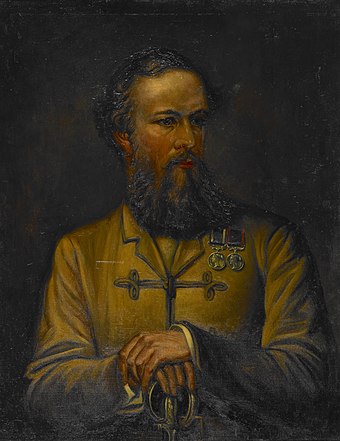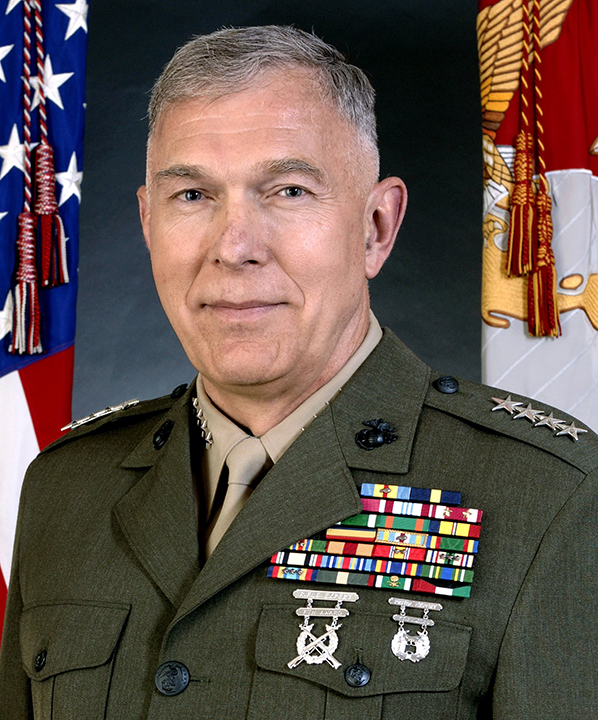General John W. Nicholson Jr. took command of U.S. troops in Afghanistan on 02 March 2016. His father General John Nicholson also served as general officer of United States army. John’s career in the U.S. army followed the usual path of other fellow general officers; however, he has some qualities which put him above his peers. On September 11, 2001 his office at the Pentagon was destroyed when Flight 77 crashed into the Pentagon. John was not in his office that day as he was moving to a new house. Later, a significant portion of his military career was linked with Afghanistan. His first tour of the country was command of 3rd Brigade Combat Team in eastern Afghanistan. His second tour was Deputy Commander of Regional Command South and third tour as Deputy Chief of Staff of commander of US forces in Afghanistan. In between, he also served as Director of Afghanistan-Pakistan Coordination Cell at Pentagon.
In 2007, then Colonel John Nicholson was commanding 3rd Brigade Combat Team of 10th Mountain Division and deployed in eastern Afghanistan. 3rd Brigade Combat Team was headquartered in Jalalabad and responsible for four provinces i.e. Nangarhar, Nuristan, Kunar and Laghman. On March 2007, a Marine Special Operations platoon was hit by a suicide bomber near the village of Spinpul on the main highway near Jalalabad. Only one soldier had a minor wound but soldiers opened indiscriminate fire while driving down the road, killing several civilians. John was commanding Task Force Spartan and the incident happened in his area of operations. He offered apology to local elders and in a statement to the local media, John apologized stating that “We are filled with grief and sadness at the death of any Afghan, but the death and wounding of innocent Afghans at the hand of Americans is a stain on our honor and on the memory of the many Americans who have died defending Afghanistan and the Afghan people.” Marine Corps Commandant General James Conway, many other officers and Congressman Walter Jones criticized John for offering the apology. In March 2016, when he landed in Afghanistan as commander of US forces, his first visit was to Kunduz where he apologized to local Afghans for the tragic mistake of last October when a hospital was hit by an air strike killing innocent civilians. These acts show the moral courage of the officer to stand up and admit mistakes publicly.
According to Carlotta Gall, General John W. Nicholson Jr. is a distant relative of a legendary figure of the Raj, Brigadier General John Nicholson. Though separated by a span of 170 years, both share some interesting characteristics and association with Afghanistan and Pushtuns. Both are men of two different eras.
John Nicholson, a sixteen year old Irishman set sail for India in 1839 to join 41st Bengal Native Infantry (BNI) in Benares. In December of that year he was transferred to the 27th Bengal Native Infantry and he joined his regiment in March 1840 then stationed at the border town of Ferozpur. In early 1841, 27th BNI was ordered to Afghanistan to relieve 16th BNI. Nicholson arrived in Jalalabad with his regiment, a town where his distant relative with the same name would base his headquarters one hundred and seventy years later. He then moved on to Ghazni to relieve 16th BNI. In March 1841, Nicholson drew his sword in the most disadvantageous circumstances against Afghans in Ghazni. After the fall of Ghazni, he was captured by Afghans.
He marched back with his regiment from Afghanistan to Meerut. He was a commissariat officer during Anglo-Sikh wars and he was present at Mudki, Ferozshah and Sobraon. After annexation of Punjab in 1849, many young officers serving under Henry Lawrence were dispatched to administer newly acquired territories of East India Company.
Four Nicholson brothers served and died in India. Alexander Nicholson was killed during retreat from Kabul and buried by his brother John. William Maxwell Nicholson joined Bombay Native Infantry regiment and died at Sukkhar at the age of twenty in June 1849. Charles Nicholson was commissioned in 31st Bengal Native Infantry. He was with his brother John during the siege of Delhi in 1857 and both brothers were lying next to each other in a hospital tent, John with a mortal wound and Charles with his right arm amputated. Charles died in 1862 when he was going to take command of a Gurkha battalion.

Nicholson of the nineteenth century had the advantage that other young men destined to become legends were his companions in the arduous task while Nicholson of twenty first century did not have that advantage. When Nicholson took charge of Rawalpindi district, George Lawrence became deputy commissioner in Peshawar, James Abbott in Hazara, and Reynell Taylor in Bannu, while Herbert Edwards came a little while later to take charge of Peshawar. Later, Nicholson served as Deputy Commissioner of Bannu and Peshawar.
In the dark early days of the 1857 mutiny, when Nicholson reached the Delhi ridge, some of the best soldiers of the Company were encamped there. The list included Alexander Taylor (later General) Neville Chamberlain (later Field Marshall), William Hodson (father of famous Hodson Horse regiment still on ORBAT of Indian army), John Coke (later Major General and father of Coke’s Rifles; now 7 Frontier Force Regiment of Pakistan army), Henry Daly (later General and father of 1 Punjab Cavalry that after many re-organizations now 11 PAVO Cavalry of Pakistan army) and Frederick Roberts (later Field Marshal).
In 1849, a small group of Hindu devotees declared Nicholson a new incarnation of God and started worshipping him. The sect was called Nikalsainis. Nicholson was puritan and had his followers flogged and imprisoned for the blasphemous act. However, they took the punishment like martyrs, and the more they suffered at his hands, the louder would they would chant their hymns in honor of the mighty Nikalsain. Not many colonial masters can claim to be worshipped by natives.
John Nicholson resented all plundering of the people by an army in the field. After the battle of Chillianwallah he flogged many soldiers for plundering. He wrote to his master Sir Henry Lawrence asking for powers of Provost Marshall and declaring that ‘If I get them, rely on my bringing the army to its senses in two days’. In 1854, chief commissioner John Lawrence was touring the Trans-Indus frontier. Captain Young husband commanded the body of frontier police which formed his escort. Suddenly, a very angry Nicholson appeared. Behind him came his orderly, leading a gold-laced, scarlet-coated jamadar of chuprassies (native assistants). He told Lawrence that the scoundrel was taking commission for the supplies brought into this camp. Nicholson then announced that “I am going to flog him. You have no objection, have you?” The jamadar was publicly flogged and the people of that district knew that the new Sheriff in town was just and would not tolerate the greed and tyranny of even his own. This was the reason that John Nicholson was not popular with his brother officers. The same is true to some extent about the John Nicholson of twenty first century.
John Nicholson recruited local Sikhs, Punjabi Muslims and Pathans for military and police duties. He earned their respect and admiration and was not averse to taking risks. When present day John Nicholson was commanding 3rd Brigade Combat Team of 10th Mountain Division in eastern Afghanistan, he was not very risk averse. He established several Forward Operation Bases (FOBs) and Combat Out Posts (COPs) and coordinated with locals. Muhammad Hayat Khan was orderly of John Nicholson, his father Fateh Khan had served Nicholson and died on the side of his master during the attack on Margalla tower in 1848. Hayat was serving with Peshawar police when mutiny broke out and throughout the campaigns he remained with Nicholson. He was with Nicholson at the time of latter’s death. In nineteenth century India, loyalty was personal. Hayat family produced many army officers and Lieutenant General ® Ahsan Azhar Hayat of the Pakistan army belongs to that family. Present day John Nicholson doesn’t have the luxury of having such loyal natives. In the twenty first century, the nature of loyalty is changed. Many patriotic Afghans left the life of comfort in North America and Europe to make a difference and many died in Afghanistan.

John Nicholson of the twenty first century is appointed in a war theatre at a challenging time. In one generation, the United States saw defeat of two field armies and there are many reasons for that. An Army marches and retreats on the orders of political masters. American public was tired of two prolonged wars and the bill was put on credit card. In view of economic recession and negative public opinion, no political leader could sell the war, therefore President Obama pulled back military from both theatres.
All kinds of passengers climb on when the war train leaves the station. The passenger list usually includes patriots, true believers, idealists, opportunists, thieves, carpet baggers, charlatans, jugglers and fortune tellers. John’s job is now essentially to keep a lid on violence to an extent that it does not disrupt the routine function of Afghanistan government. The role of soldiers in this exercise is limited to training, logistical and air support and intelligence. The most difficult task which John will share with his diplomatic colleagues is to mediate between rival Afghan ruling elite. He will need the patience of Job to perform this task. He may ponder over the advice of T. E. Lawrence that “It is their war and you are to help them, not to win it for them”. In dealing with local Afghans, he may ponder over the statement of John Nicholson of the nineteenth century, “Never remove a native official unless you know that you can replace him by a better one, otherwise you will get an equally stupid or corrupt man, minus the experience of his predecessor.”
“I would much rather earn the good opinion of my friends than any kind of honorary distinction’.
John Nicholson 1857
References
– Captain Lionell J. Trotter. The Life of John Nicholson: Solider and Administrative (London: John Murray, 1898)
– The Washington Post, May 09, 2007
– Carlotta Gall. The Wrong Enemy (New York: Houghton Mifflin Harcourt, 2014)





